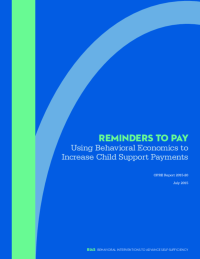Reminders to Pay
Using Behavioral Economics to Increase Child Support Payments

The Behavioral Interventions to Advance Self-Sufficiency (BIAS) project is the first major opportunity to use a behavioral economics lens to examine programs that serve poor and vulnerable families in the United States. Sponsored by the Office of Planning, Research and Evaluation of the Administration for Children and Families in the U.S. Department of Health and Human Services and led by MDRC, the project applies behavioral insights to issues related to the operations, implementation, and efficacy of social service programs and policies. The goal is to learn how tools from behavioral science can be used to deliver programs more effectively and, ultimately, improve the well-being of low-income children, adults, and families.
This report presents findings from two behavioral interventions designed to increase the collection of child support payments in Franklin County, Ohio. The interventions were intended to increase the number of parents who made a child support payment, as well as increase the dollar amount of total collections per parent. In particular, the Franklin County Child Support Enforcement Agency (FCCSEA) was focused on noncustodial parents who do not have their child support payments automatically deducted from their paychecks, as these parents need to take action each month to make a payment. Using a process of behavioral diagnosis and design, the BIAS team found that over half of the parents who owed child support did not have a recent history of making payments via income withholding, and moreover, that many of these parents were not being sent regular payment reminders. The BIAS team hypothesized that reminding these parents to pay their child support could increase the occurrence and amount of their payments.
The BIAS team, in collaboration with FCCSEA, tested two low-cost payment reminder interventions for parents who did not have income withholding, using random assignment experiments over four months. The first test targeted parents to whom payment reminder notices were not being sent. The second test targeted parents who were already being mailed monthly payment reminder notices. This second test compared the effectiveness of a new payment reminder notice that incorporated behavioral principles with the current payment reminder notice being sent by Ohio’s Child Support Payment Central (CSPC) — the state’s payment processing center.
The first test found that reminders produced a modest but statistically significant increase of 2.9 percentage points in the number of parents who made at least one child support payment over four months. Compared with the control group payment rate of 48.5 percent, 51.5 percent of noncustodial parents who were sent a payment reminder made a payment. However, there was no statistically significant increase in total collections per person, suggesting that these additional payments were small. In the second test, the redesigned payment reminder notice and current CSPC payment reminder performed comparably, and no statistically significant differences in the number of parents paying or the dollar amount of payments were found. The findings reviewed in this report are consistent with the existing behavioral science literature, which demonstrates that reminders can influence people’s actions. However, the modest findings suggest that the targeted noncustodial parents may have a limited ability to pay, or that the behavioral bottlenecks they face were not adequately addressed by the interventions.






